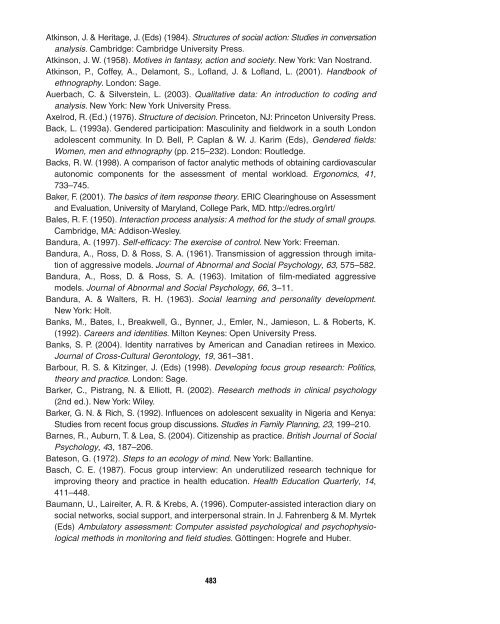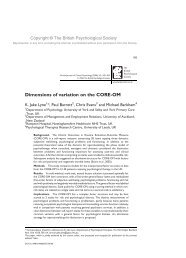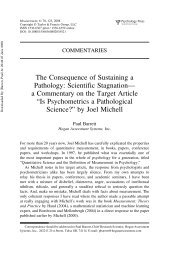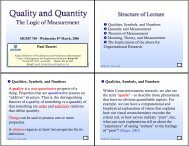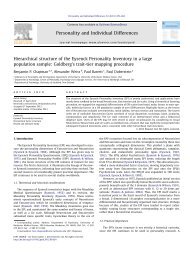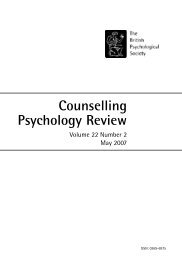Psychophysiological Methods - Paul Barrett
Psychophysiological Methods - Paul Barrett
Psychophysiological Methods - Paul Barrett
- No tags were found...
You also want an ePaper? Increase the reach of your titles
YUMPU automatically turns print PDFs into web optimized ePapers that Google loves.
Breakwell-3389-Reference.qxd 2/7/2006 9:03 PM Page 483Atkinson, J. & Heritage, J. (Eds) (1984). Structures of social action: Studies in conversationanalysis. Cambridge: Cambridge University Press.Atkinson, J. W. (1958). Motives in fantasy, action and society. New York: Van Nostrand.Atkinson, P., Coffey, A., Delamont, S., Lofland, J. & Lofland, L. (2001). Handbook ofethnography. London: Sage.Auerbach, C. & Silverstein, L. (2003). Qualitative data: An introduction to coding andanalysis. New York: New York University Press.Axelrod, R. (Ed.) (1976). Structure of decision. Princeton, NJ: Princeton University Press.Back, L. (1993a). Gendered participation: Masculinity and fieldwork in a south Londonadolescent community. In D. Bell, P. Caplan & W. J. Karim (Eds), Gendered fields:Women, men and ethnography (pp. 215–232). London: Routledge.Backs, R. W. (1998). A comparison of factor analytic methods of obtaining cardiovascularautonomic components for the assessment of mental workload. Ergonomics, 41,733–745.Baker, F. (2001). The basics of item response theory. ERIC Clearinghouse on Assessmentand Evaluation, University of Maryland, College Park, MD. http://edres.org/irt/Bales, R. F. (1950). Interaction process analysis: A method for the study of small groups.Cambridge, MA: Addison-Wesley.Bandura, A. (1997). Self-efficacy: The exercise of control. New York: Freeman.Bandura, A., Ross, D. & Ross, S. A. (1961). Transmission of aggression through imitationof aggressive models. Journal of Abnormal and Social Psychology, 63, 575–582.Bandura, A., Ross, D. & Ross, S. A. (1963). Imitation of film-mediated aggressivemodels. Journal of Abnormal and Social Psychology, 66, 3–11.Bandura, A. & Walters, R. H. (1963). Social learning and personality development.New York: Holt.Banks, M., Bates, I., Breakwell, G., Bynner, J., Emler, N., Jamieson, L. & Roberts, K.(1992). Careers and identities. Milton Keynes: Open University Press.Banks, S. P. (2004). Identity narratives by American and Canadian retirees in Mexico.Journal of Cross-Cultural Gerontology, 19, 361–381.Barbour, R. S. & Kitzinger, J. (Eds) (1998). Developing focus group research: Politics,theory and practice. London: Sage.Barker, C., Pistrang, N. & Elliott, R. (2002). Research methods in clinical psychology(2nd ed.). New York: Wiley.Barker, G. N. & Rich, S. (1992). Influences on adolescent sexuality in Nigeria and Kenya:Studies from recent focus group discussions. Studies in Family Planning, 23, 199–210.Barnes, R., Auburn, T. & Lea, S. (2004). Citizenship as practice. British Journal of SocialPsychology, 43, 187–206.Bateson, G. (1972). Steps to an ecology of mind. New York: Ballantine.Basch, C. E. (1987). Focus group interview: An underutilized research technique forimproving theory and practice in health education. Health Education Quarterly, 14,411–448.Baumann, U., Laireiter, A. R. & Krebs, A. (1996). Computer-assisted interaction diary onsocial networks, social support, and interpersonal strain. In J. Fahrenberg & M. Myrtek(Eds) Ambulatory assessment: Computer assisted psychological and psychophysiologicalmethods in monitoring and field studies. Göttingen: Hogrefe and Huber.483


